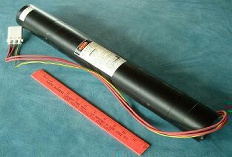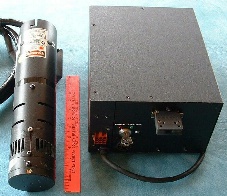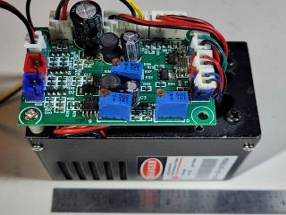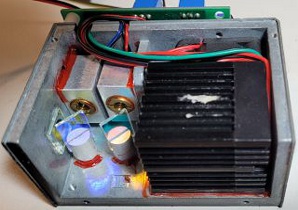|
|









The Lasers
Lasers I've collected and used for laser shows or just for fun
This page's purpose is two fold - One, so I can display the various lasers I have collected over the years, and two, just to pass
along some info I have gathered from various sources over the years or just things I've learned from experience as a laser
hobbyist. I'll start with the old gas lasers in my collection and work down to the newer solid state lasers I have.
15mW Helium-Neon Laser
Notice the manual
aperture shutter
40mW Helium-Neon Laser
with internal power
supply
This is a 30mW Argon laser tuned to output
a violet beam. It requires about 15 amps
from the 110V outlet! Not very efficient...
These old lasers are fun just to mess around with but not very practical in terms of usefulness to a laser hobbyist... that's
assuming you can even get them to work any more. The beams are near perfect though, much better than the odd beam
shapes you get out of many of the inexpensive solid state lasers. Most gas lasers you can find for an affordable price are
non-functional, but a lot of good repair and general info can be found on these in the Sam's Laser FAQ website if you are
willing to try to bring one of these old beasts back to life (assuming the laser tube is even still capable of lasing). For the
Argon and Krypton gas lasers you will also need to provide a good bit of air flow for the laser modules or they will burn out.
They will heat a room up fairly quickly!
This is another argon laser but it
outputs a light blue beam. You can
see the large opening at the top of
the laser housing which is where the
high CFM fan would mount to pull the
cooling air
through the laser cooling fins. This laser draws about 20 amps from the 110V outlet.
Above is bare a laser tube - you can see the cooling fins and the structure of the
argon laser tube. With the fan running these laser are pretty noisy.
The lasers below are some of the newer ones that I have, all solid-state laser diode type. The efficiency of these compared
to the gas lasers is like night and day. Some of my gas lasers require 2,000+ watts of input power and only output 30 or 40
milliwatts of laser light! Solid-state lasers only require a few watts of input power and can output hundreds of milliwatts or
more of laser light, and don't require nearly as much in the way of cooling either. Think of how long a laser pointer lasts on
two AAA batteries, or even a few of those tiny button-cell batteries. It's no wonder why gas laser use has diminished or
completely dissapeared from most applications.
I have a bunch of miscellaneous laser pointers and small modules of various wavelengths and will not try to list or show them all here other that maybe a few examples. I do have a few mixed wavelength laser modules which I've included on this page.
I have a bunch of miscellaneous laser pointers and small modules of various wavelengths and will not try to list or show them all here other that maybe a few examples. I do have a few mixed wavelength laser modules which I've included on this page.
This is a Chinese combined beam (white light)
laser module with a laser driver board and
internal fan, as it can get a little warm. The
claimed output is about 400mW of laser light
(serious power) but I don't currently have a
way of measuring the combined beam power.
The image to the right is a shot of the internals of this laser module. You can see the fan behind the black heat sink and the two dichroic mirrors redirecting the specific wavelengths of the two smaller lasers while the larger laser shines right through them, thus combining the beams into a single beam.
The image to the right is a shot of the internals of this laser module. You can see the fan behind the black heat sink and the two dichroic mirrors redirecting the specific wavelengths of the two smaller lasers while the larger laser shines right through them, thus combining the beams into a single beam.












